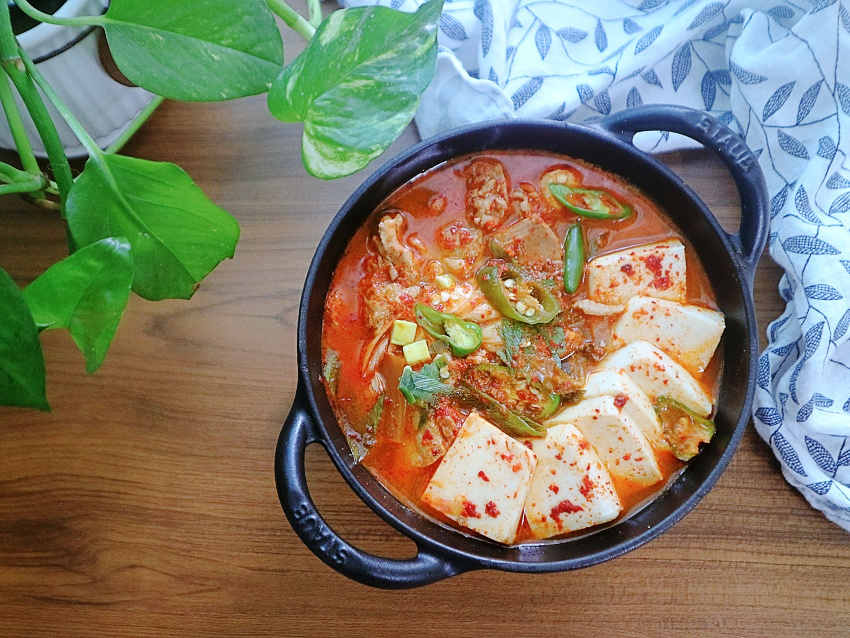Spicy and Rich Pork Kimchi Stew (Kimchi Jjigae)
How to Make Delicious Pork Kimchi Stew like Baek Jong-won: A Foolproof Recipe with Tofu

As the weather gets colder, a warm bowl of kimchi stew is the perfect comfort food that chases away the chill and pairs wonderfully with rice! Today, I’m sharing Baek Jong-won’s secret recipe for an even richer and deeper flavored pork kimchi stew. Using slightly sour, fermented kimchi and enhancing the savory notes with pork and fermented shrimp (saeujeot) creates a dish everyone will rave about. Adding plenty of tofu makes it a hearty and satisfying meal. This recipe ensures you can easily make a delicious kimchi stew at home that rivals restaurant quality. Let’s get started! (Measurements are based on a Korean rice spoon; a standard measuring cup is 200ml)
Main Ingredients- Pork (neck, shoulder, or belly recommended) 250g
- Well-fermented sour kimchi 350g
- Tofu 160g (approx. 1/2 block)
- Green onion (scallion) 15cm long
- Cheongyang chili peppers 2
Seasonings and Broth- Coarse gochugaru (Korean chili flakes) 2 Tbsp
- Fine gochugaru (Korean chili flakes) 1 Tbsp
- Guk-ganjang (Korean soup soy sauce) 1 Tbsp
- Minced garlic 1 Tbsp
- Saeujeot (fermented shrimp) 1.5 Tbsp (including brine)
- Water 4 cups (800ml)
- Kimchi brine 1/2 cup (100ml)
- Coarse gochugaru (Korean chili flakes) 2 Tbsp
- Fine gochugaru (Korean chili flakes) 1 Tbsp
- Guk-ganjang (Korean soup soy sauce) 1 Tbsp
- Minced garlic 1 Tbsp
- Saeujeot (fermented shrimp) 1.5 Tbsp (including brine)
- Water 4 cups (800ml)
- Kimchi brine 1/2 cup (100ml)
Cooking Instructions
Step 1
Baek Jong-won’s recipe suggests pork neck, but pork shoulder or belly with some fat will also yield a very delicious stew. We’re also adding tofu for a smoother texture. Are you new to adding kimchi brine to your stew? Adding kimchi brine significantly deepens and enriches the flavor of the kimchi stew.

Step 2
The key to a great kimchi stew is the ‘kimchi’ itself! Instead of freshly made kimchi, use ‘sour kimchi’ that has been well-fermented and is refreshingly tangy – this is the secret to its delicious taste. Cut the kimchi into bite-sized pieces (about 2-3 cm).

Step 3
Cut the pork into bite-sized pieces (about 2-3 cm) and place them in the pot. Begin by adding 3 cups (600ml) of water and bring to a boil over high heat. As it cooks, the liquid may reduce, so be prepared to add an additional cup (200ml) of water later if needed.

Step 4
As soon as the pork starts to cook, add 1.5 Tbsp of saeujeot (fermented shrimp). Saeujeot not only removes any porky odor but also adds a savory depth that makes the kimchi stew even more delicious – it’s a secret ingredient! If you don’t have saeujeot, you can substitute it with fish sauce (like anchovy or sand lance). Kimchi stew tastes best when the fat from the pork melts into the broth, so it’s important to simmer it well from the start over high heat. Don’t worry about skimming off the foam that rises to the surface; it actually helps create a deeper flavor. While you can use 2-3 Tbsp of coarse gochugaru alone, today we’ll mix coarse and fine gochugaru. Add 1 Tbsp of guk-ganjang (soup soy sauce) and 1 Tbsp of minced garlic to enhance the aroma.

Step 5
Prepare the kimchi brine to further enhance the stew’s depth and richness. Strain the kimchi brine through a sieve to remove solids, using about 1/2 cup (100ml) of the clear liquid. This will provide a much deeper flavor than using plain water alone.

Step 6
Once all the ingredients begin to meld, reduce the heat to medium-low. Simmer gently and for a long time, ensuring the stew doesn’t boil over, allowing the flavors of the ingredients to fully infuse.

Step 7
After the broth has sufficiently reduced and the ingredients are tender, add half of the sliced green onions and cheongyang chili peppers, along with half of the tofu, and simmer for another 5 minutes. Adding tofu towards the end helps prevent the broth from becoming cloudy.

Step 8
For immediate serving, ladle the kimchi stew into a smaller pot. Decoratively arrange the remaining green onions, cheongyang chili peppers, and tofu on top, then bring it to a brief boil. This makes the kimchi stew even more appealing and delicious.

Step 9
It’s often said that kimchi stew tastes even better the next day! This is because reheating it and simmering it again allows the flavors to meld even more deeply. I definitely enjoyed it over two days!

Step 10
Making pork kimchi stew after a long time was truly a rice thief! Thanks to this deliciously simmered stew, one bowl of rice was not enough.

Step 11
Are you wondering what to make for dinner tonight? Then I highly recommend a hearty pork kimchi stew, simmered slowly with well-fermented sour kimchi and plenty of pork! If the kimchi isn’t sour enough for your liking, add a tiny splash of vinegar and a pinch of sugar to significantly enhance its savory notes. Enjoy your delicious, homemade kimchi stew with a warm bowl of rice!



